
This gallery contains 2 photos.
On the way back from further north, I stopped by Sandgate for another brief look – brief as the missus was in the car. 😉 Trains in the Hunter are a little boring to look at, in that the majority … Continue reading


This gallery contains 2 photos.
On the way back from further north, I stopped by Sandgate for another brief look – brief as the missus was in the car. 😉 Trains in the Hunter are a little boring to look at, in that the majority … Continue reading

This gallery contains 1 photo.
Being a public holiday, when a friend (raichase), suggested we head to the Hunter Valley for some rail photography, I thought “why not?” – I got a leave pass from the missus, and off we went. Sadly though the public … Continue reading
Updated 30 October 2012
I am restructuring this page as a detailed summary of all known RailCorp spoil wagons. Once complete, the old posts will be removed, and this republished.
I hope to have one representative photo of each wagon, with links to more photos I have uploaded on Flickr.
Wagon code check letters are not always visible, legible, or even present, but I’ve filled what I can.
NACF (former NDSF)
A former NDSF side tipper with the sides welded shut, and the lifting gear removed – I am only aware of the one conversion at this stage.
Codes:
– 1470B
Modelling: No model that I am aware of – scratchbuild.
NDBF
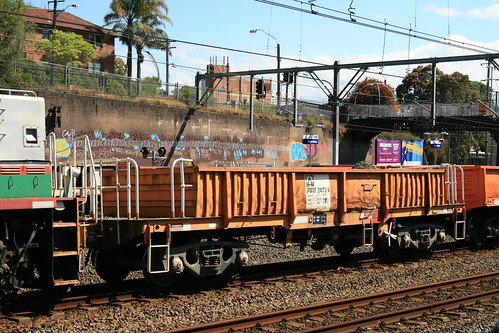
More photos
Formerly a BD/NOAF open wagon, the NDBF has a shortened open section to allow end decks – this means whereever it is in the consist, it allows passage from one side of the train to the other. It can also be used as a shunter’s float, and is typically seen at the ends of the consist (occasionally around the middle also).
You can see in some photos signs for the “Emergency Brake Release Valve” – a friend has advised that these wagons are also fitted with a very primitive brake valve for the use of the person controlling the propelling movement … basically it’s just a standard ball cock valve mounted up on the handrails.
Codes
All the below have long decks, unless otherwise noted.
– 1602Y
– 2067C
– 2071C
– 2072L
– 2075P
– 2081K (two large ribbed panels on one side now replaced by flat panels)
– 2083E?
– 2540E
– 2542W (rebuilt – all side panels flat)
Modelling: Richmond Line Models NDBF, or kitbash Silvermaz BD/NOAF.
NDCF
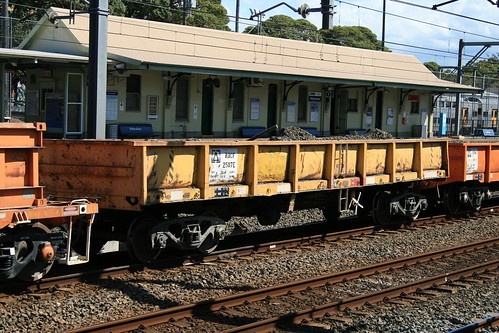
More photos
The NDCF I understand to be converted from GP/NOHF concentrate wagons, and at one stage I believe were all painted yellow. Recently however they are being repainted in bright orange.
Codes:
– 1609A (noted as yellow 13/10/2012)
– 1615S (different fabricated ends) (last noted as yellow 13/10/2012)
– 2091K (first noted as orange 13/10/2012)
– 2096C (now orange)
– 2098E (first noted as orange 13/10/2012)
– 2103J (last noted as yellow 25/08/2012)
– 2503Y (pressed ends) (first noted as orange 13/10/2012)
– 2506S (last noted as yellow 13/10/2012)
– 2507E (last noted as yellow 13/10/2012)
– 2524Q (last noted as yellow 13/10/2012)
– 2761U (last noted as yellow 25/08/2012)
– 2936B (first noted as orange 13/10/2012)
Modelling: Kitbash Silvermaz GP/NOHF.
NDCH (type one – ex NOBX)
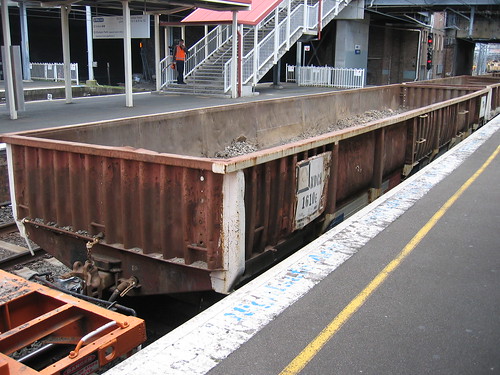
More photos
Formerly common, but now harder to find are the rusty old NDCHs that originate from NOBX open wagons.
The majority seem to be rib-sided with flat panels where the doors used to be, however there is at least one with all flat panels. There is a mixture in the ends also – I believe the flat paneled wagon(s) have flat ends, where the rib-sided ones have either pressed or corrugated ends – some have one of each.
Codes
– 1610E (ribbed ends)
– 2063M (ribbed ends) (last noted as rust brown 13/10/2012)
– 2074G (one ribbed end, one pressed end)
– 2526T (ribbed ends) (last noted as rust brown 13/10/2012)
– 2751
– 2754Q (one ribbed end, one pressed end)
– 2760L (pressed ends)
Modelling: Plain-sided, IDR Castings NDCH. Rib-sided, kitbash AR Kits BDX/NOBX or IDR Castings NDCH.
NDCH (type two – ex NOGF/NOGX)
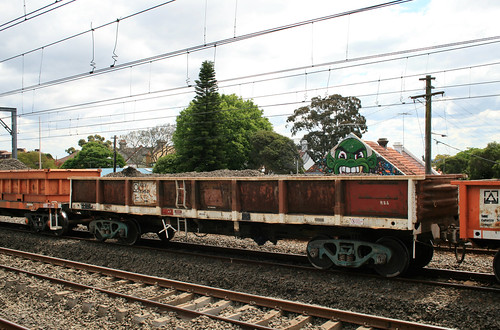
More photos
The second type of NCDH is easily distinguished by it’s different underframe, and that they all have flat panels the whole length of the wagon. The origins of this wagon appear to be NOGF and NOGX (HGM/HGX) wagons based on information on the Comrails website. It also mentions NOAF (BD) wagons, but I believe these to have been recoded NDNF (see below).
Codes:
– 1613X (pressed ends, two codeboards each side) (last noted as rust brown 13/10/2012)
– 2101Y?
– 2502N (pressed ends) (first noted as orange 13/10/2012)
– 2528R? (fabricated ends) (noted as rust brown 25/08/2012)
– 2534J? (codeboards mostly illegible – one pressed end, one NDCF style end) (last noted as rust brown 13/10/2012)
– 2545D (pressed ends) (last noted as rust brown 13/10/2012)
– 2769A (fabricated ends) (first noted as orange 13/10/2012)
Modelling: Kitbash Silvermaz HGM/HGX/NOGF/NOGX.
NDMX
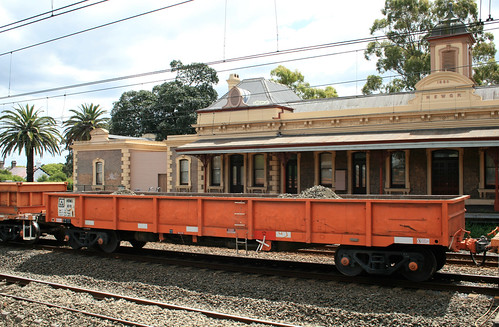
More photos
Whilst I have seen Louvre Vans such as the NLGX mentioned as the origin of the NDMX, some research and debate has led me back to the NOBX open wagon. See Railpage for details.
They were easily distinguished from other spoil wagons in that they were the only ones painted blue, however they are rapidly being repainted bright orange, and I haven’t seen a blue NDMX for a while.
Codes:
– 1801V (first noted as orange 13/10/2012)
– 1802H (first noted as orange 13/10/2012)
– 1804C (first noted as orange 13/10/2012)
– 1805L (first noted as orange 13/10/2012)
– 1808P (first noted as orange 13/10/2012)
– 1809B (first noted as orange 13/08/2011)
– 1810U (last noted as blue 13/08/2011) (first noted as orange 13/10/2012)
– 1811G (first noted as orange 13/10/2012)
– 1812L (first noted as orange 13/10/2012)
– 1813B (first noted as orange 13/10/2012)
– 1815T (first noted as orange 13/10/2012)
– 1816F (first noted as orange 13/10/2012)
– 1817Y? (first noted as orange 13/10/2012)
– 1819J (first noted as orange 13/08/2011)
– 1820F (first noted as orange 25/08/2012)
Modelling: Kitbash IDR Castings NDCH, or use bases from AR Kits NOBX.
NDNF
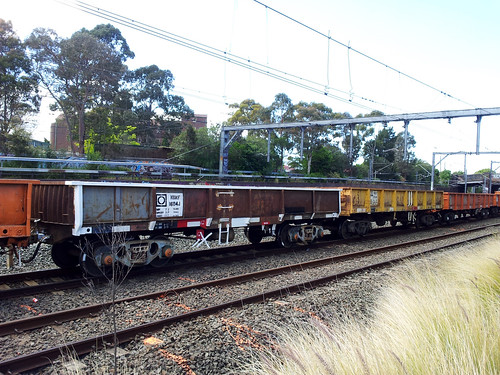
More photos
Similar to the NDBF, the NDNF is also a former BD/NOAF wagon, but with the full length being open (ie no end decks). Note most have partially corrugated sides and pressed ends, however NDNF 2637N has completely flat side panels, and NDNF 2536E had one pressed end, and one corrugated end.
Codes:
– 1604J (flat panels one side, though one reenforced – ribbed ends) (last noted as rust brown 13/10/2012)
– 2066Q?
– 2531?
– 2536E (pressed ends) (last noted as rust brown 13/10/2012)
– 2537N (flat panelled)
Modelling: Kitbash Silvermaz BD/NOAF.
NDQF
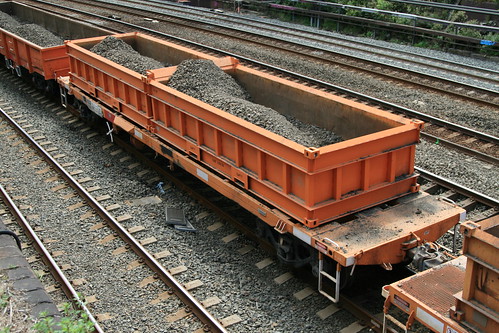
More photos
The NDQF container wagons are usually seen these days carrying spoil bins. They, along with the NQJX have also been leased out to private operators in the past, to be used as normal container wagons (for example Silverton trip trains).
I understand that these wagons are former NDXF concrete sleeper wagons (some of which are now NDYF concrete sleeper wagons), which in turn are cut down NOBX open wagons.
Codes:
– 1608K
– 2050L
– 2084C
– 2089B
– 2623K
– 2627A
– 2636W
– 2666A
– 2680X
– 2685H
– 2751A
– 2755N
– 2756W
– 2757X
– 2773L
Modelling: No model that I am aware of – scratchbuild, possibly using an NOBX as reference for measurements.
NDSF (type one – reinforced panels)
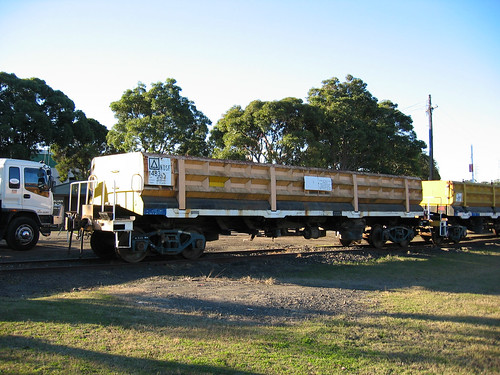
More photos
The NDSF is a side-dumping wagon, generally used to deliver ballast, but sees occasional use on spoil trains. It comes in two types distinguished by how much angular support the sides have.
Some useful info, pictures, and line drawings can be found on Railpage.
Codes:
– 1470 (now NACF 1470B)
– 1482L (noted still yellow 27/10/12)
– 1483V (noted orange 27/10/12)
– 1484H
Modelling: No model that I am aware of – scratchbuild.
NDSF (type two – flat panels)
The NDSF is a side-dumping wagon, generally used to deliver ballast, but sees occasional use on spoil trains. It comes in two types distinguished by how much angular support the sides have.
Some useful info, pictures, and line drawings can be found on Railpage.
Codes:
– 1476R
– 1477
– 1479V
– 1480
Modelling: No model that I am aware of – scratchbuild.
NDVF
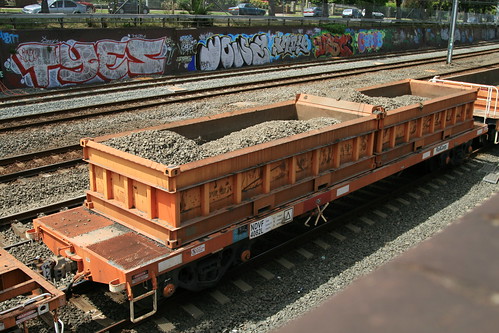
More photos
Ten NDVF container wagons were built in 2005 by UGL at the Goulburn Rolling Stock & Fabrication Centre, and they are a complete new build.
Codes:
– 4080Q
– 4081C
– 4082L
– 4084G
– 4085P
– 4087K
– 4089F
Modelling: No model that I am aware of – scratchbuild.
NHSF
Another side-dumping wagon used mainly for delivering new ballast, the NHSF do see occasional use on spoil trains.
Again some useful info and pictures can be found on Railpage.
Codes:
– 1460J
– 1462E
– 1463N
– 1464W
– 1466R
Modelling: No model that I am aware of – scratchbuild. American style Difco side dumpers are similar however.
NQAF
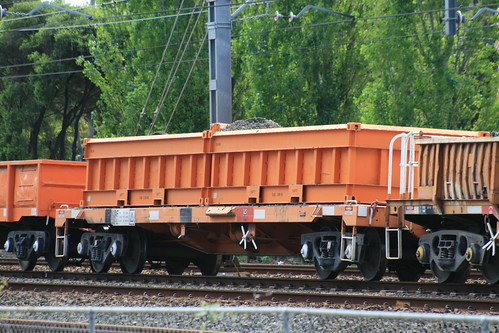
More photos
A more recent wagon type is the NQAF. This is an unusual wagon, which are former NLJF “jewellery vans”, which in turn are former NLHX lourve vans. RailCorp had four of these jewellery vans, which travel at the end of concrete sleeper rakes, and have seats and equipment below floor level to allow pandrol clips to be placed on to newly laid track, but I have only ever seen NLJF 2072K in service. The other three (2071, 2073, and 2074) have since been cut down and converted into NQAF container wagons.
Codes:
– 2701H
– 2703C
– 2704L
Modelling: No model that I am aware of – scratchbuild, or heavy kitbash of AR Kits or On Track Models HLX/NLHX louvre van.
NQJX
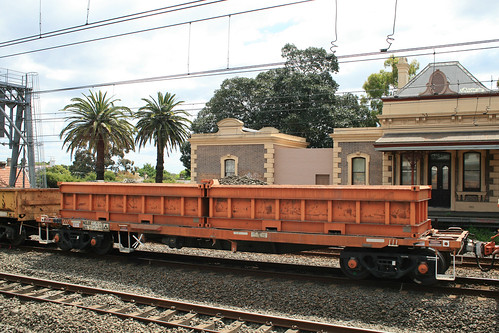
More photos
The NQJX container wagons are usually seen these days carrying spoil bins. They, along with the NDQF have also been leased out to private operators in the past, to be used as normal container wagons (for example Silverton trip trains).
These wagons are cut down NOBX open wagons. The possible exception is NQJX 10101L, which the NSW Rollingstock site reports came from an unknown louvre van, though it doesn’t have the characteristic louvre van ends, and the code boards show the same weight, capacity, and only a minor difference in length between 10101L and the other NQJX wagons (14.9m vs 14.96m). It is probable that NQJX 10101L is also a former NOBX.
Codes:
– 10101L
– 10102U
– 10105B
– 10106K
– 10107T
– 10108F
– 10109Y (missing code board on one side 23/10/2012 – spray painted number)
– 10110K
– 10111T
– 10112F
– 10113Y
– 10115J
– 10116S
– 10117E
– 10118N
– 10120S
– 10121E
Modelling: Hanovale or Scaleways NQJX, if either is available. Otherwise scratchbuild using an NOBX as reference for measurements.
Credits
I wish to thank Chris Jones for helping me fill in some gaps, the NSW Rollingstock website, the Comrails website for providing leads on the origins of some wagons, and those on Railpage that were able to provide information also.

This gallery contains 18 photos.
On Saturday we took a day trip to Bowral to see if the tulips were in bloom yet, as we won’t be able to make the festival proper … here’s some pics (post two of two) …

This gallery contains 32 photos.
On Saturday we took a day trip to Bowral to see if the tulips were in bloom yet, as we won’t be able to make the festival proper … here’s some pics (post one of two) …

This gallery contains 12 photos.
Last in the series is the NHSF, another side dumper – again some useful info and pics can be found at http://www.railpage.com.au/f-t11339456-s0-0-asc.htm No model is available that I know of, though an Amercian Difco side-dumper could probably be kit-bashed into … Continue reading

This gallery contains 22 photos.
Updated 3 October 2012 The NDSF is a side-dumping wagon, and seems to come in two types distinguished by how much angular support the sides have. You can find some useful information on these on Railpage, including a friend’s photos … Continue reading

This gallery contains 12 photos.
Whilst I have seen Louvre Vans such as the NLGX mentioned as the origin of the NDMX, some research and debate has led me back to the NOBX open wagon. See http://www.railpage.com.au/f-p1595453.htm#1595453 for details. They were easily distinguished from other … Continue reading

This gallery contains 14 photos.
The second type of NCDH is easily distinguished by it’s different underframe, and that they all have flat panels the whole length of the wagon. The origins of this wagon appear to be NOGF and NOGX (HGM/HGX) wagons based on information … Continue reading

This gallery contains 12 photos.
Updated 3 October 2012 Technically speaking, the NQJX and NDQF are not spoil wagons, but rather they are 2TEU (two “twenty foot equivalent”) container wagons. I include them here however as they are often seen carrying spoil bins as per … Continue reading